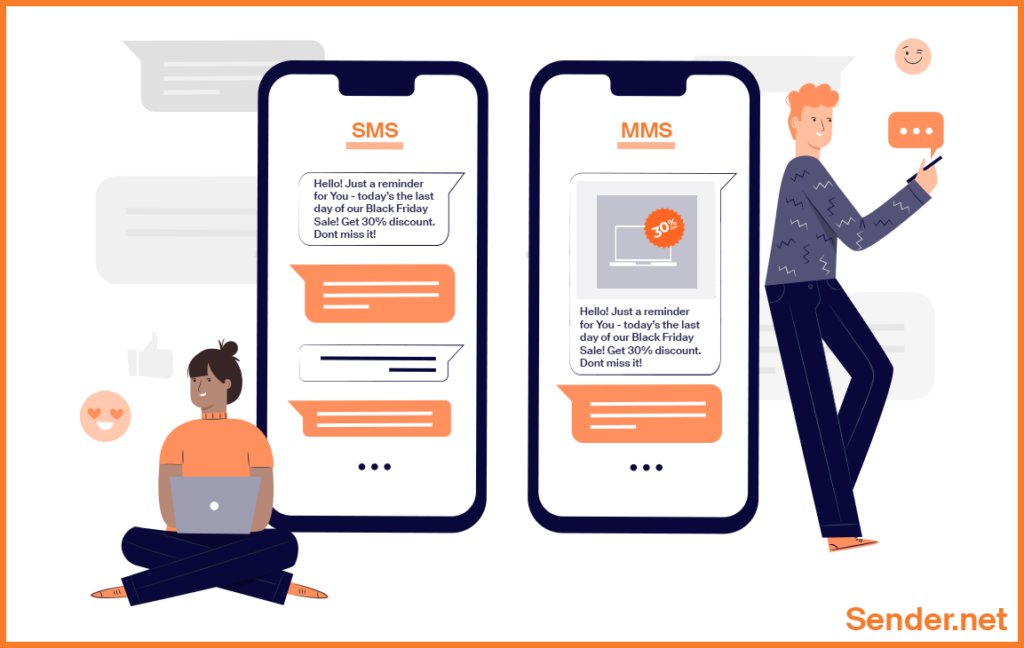Most people are quite familiar with SMS. It used to be the most used way of messaging friends, family, and businesses back in the day.
While it no longer is as popular, it’s still a powerful marketing channel.
MMS, however, haven’t had their time to shine too much. In fact, it’s likely most people haven’t, at least intentionally, sent an MMS in their lives. They used to be costly and quite difficult to get a hang of. As a result, MMS messages never caught on.
Both formats do have their place in marketing, especially since these channels are experiencing a sort of revival. In order to make things easier for you, in this article, we’ll go through what is SMS and MMS, their differences, and use cases.
What is an SMS Message?
It’s actually quite easy to define SMS. SMS is an abbreviation for Short Message Service. Since it’s quite a long name, the abbreviation caught on and people didn’t look back.
Is there a difference between a text message and an SMS message? Not really. SMS is simply one of the text message formats available nowadays. In fact, for the longest time SMS and “texting” was synonymous.
Additionally, there’s a slight difference between what is SMS on iPhones and what is SMS on Facebook. While people use these terms synonymously, SMS on the native phone application and on any other application is different.
First, real SMS messages (ones on native phone apps) are limited in length. Without getting into the intricacies of the system, generally, a single SMS is 160 characters long. On Facebook, Viber, WhatsApp, and other applications, the message length is (almost) unlimited, meaning these are two different concepts.
SMS on third-party apps are simply texting. They do not follow the regular limitations of SMS messaging. Even the regulations and laws, when mass messaging for business purposes is concerned, are different.
Finally, SMS messages are limited to being text-only. Links and emojis can be included. Images, GIFs, videos, or any other multimedia, however, are off-limits. Incidentally, sending an image over an SMS messaging service would turn the message into an MMS message.
Also read:
What is an MMS Message?
As it may be obvious now, the answer to what does MMS message mean is quite simple. By definition, it’s a Multimedia Message Service. In practice, that simply means an SMS message with any type of additional media. For example, an SMS video message would be considered MMS.
It has a small added benefit of being quite a bit longer. Instead of being limited to 160 characters, MMS messages can be up to 1600 characters in length. This benefit, however, isn’t as useful to businesses as it may seem.
Due to the way bulk marketing messaging works, there’s usually not much use for the additional space in the message. After all, would you read a marketing message that comes with an image and 1600 characters? Most people don’t, therefore sticking to short and sweet messages is usually the way to go.
Difference Between SMS vs MMS

The differences between SMS and MMS are pretty simple. We’ll compare both messaging types to help you better understand their differences.
MMS vs SMS: Comparison
SMS are basic text messages that can only be 160 characters long. You can still type over 160 characters, but it’s usually better to stick to the shorter length.
For example, a 164-character text will be broken into one 153-character text, then chained together to a 9-character text. As a result, there’s a high chance that those notifications will reach the recipient when not in order. If you’re guiding team members or customers through a step-by-step process, your instructions may start feeling like a confusing manual.
MMS messages can include multimedia such as pictures, GIFs, and videos and can be up to 1600 characters in length.
These differences become impactful when bulk messaging is concerned. When using a messaging service, MMS is significantly more expensive than SMS. Many platforms may charge twice or even three times the amount per MMS compared to SMS.
Yet, MMS messages can be significantly more effective at marketing. People are more likely to pay attention to something with a picture, video, or GIF. As a result, conversion rates may be higher.
That said, SMS is more reliable than MMS. Almost every cell phone in use today supports SMS, which can increase the delivery rate of your business texts. While iPhones and Androids support MMS, not every cell phone does. Sending an MMS to a mobile phone that can’t receive MMS messages can result in delivery issues.
So, you need careful consideration before choosing SMS or MMS for marketing purposes. It all depends on your budget and platform rules. As such, no one-size-fits-all recommendation can be given.
Pros and Cons of SMS vs. MMS
Here’s a table summarizing the pros and cons of SMS and MMS:
| SMS | MMS | |
| Pros | SMS is more reliable than MMSAll mobile phones can support SMSSMS is quite affordable | MMS messages are more effective at marketingMMS can be 1600 characters in lengthYou can add multimedia such as images, GIFs, and videos |
| Cons | SMS can only be 160 characters longYou can’t add multimedia to SMS | Not all phones support MMSMMS is more expensive than SMS |
Should I Use SMS or MMS?
It can be challenging to know when to use MMS over SMS or vice versa. Here are a few common use cases where one is more preferred over the other:
Marketing Campaigns or Special Offers – If you’re engaged in marketing campaigns, getting customers to buy your offer is crucial. While SMS is effective, it may not cause them to react. A visual can be a more powerful motivator to act than words alone. So, add an image with MMS if you want to add an incentive for customers to act.
Emergency Information – Local businesses and governments have often used SMS to get information to recipients fast. If you need to convey information quickly, keep your message alerts brief and free of distractions. SMS is the most cost-effective option, especially if additional mass text broadcasts are required.
Confirmations and Reminders – Booking confirmations and reminders are two of the most common applications for SMS. A simple text message works perfectly to notify customers that you’ve received their booking. SMS is the way to go if you just want to send reminders to your customers.
Event Invitations – Event invitations look more inviting if you include a visual incentive. Consider using helpful visuals to make your booking process more seamless. You can also send custom QR codes to attendees automatically after they book. This eliminates the need for the customer to print tickets or sift through cluttered email inboxes on the day of the event.
That said, use MMS if you’re planning to invite your customers to an event.
How Is SMS Different From Text Messages?
Short Message Service (SMS) and Text Messaging (Texting) are the same things. It’s a means of sending and receiving short messages to and from mobile phones.
SMS was first defined in 1985 as part of the GSM series. Support for the service has since grown to include alternative mobile standards such as ANSI CDMA networks and AMPS and satellite and landline networks.
SMS Marketing for Business
The average email campaign has a 20% open rate, and low conversion rates, and is largely ineffective as a one-way communication channel. As a result, your chances of losing potential customers are nil if your message doesn’t reach them.
In contrast, SMS marketing has astronomical engagement. Over 98% of all text messages are opened, and close to half of all sent text messages get a reply from highly engaged customers.
SMS marketing costs differ between countries, but they’re almost always extremely low. You can expect to pay subscription fees as low as $0.015 per SMS in the United States.
In addition, SMS platforms like Sender typically offer text marketing plans that include free messages. As a result, the pricing of SMS marketing services may be even lower than the costs outlined above, making it accessible to small businesses and large enterprises.
Get the Best Out of SMS Marketing
SMS and MMS are actually quite similar. They have two primary differences that don’t matter much to regular users. For businesses, however, keeping the differences in mind is critical as inconsiderate use of either can cause a lot of money to be wasted.
Want to make the most of your SMS and MMS marketing? Use Sender’s SMS marketing platform. All of our features, including email marketing automation, are included with every plan. You’ll get everything we have to offer even with our free plan!
Also read:


